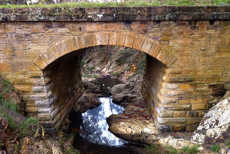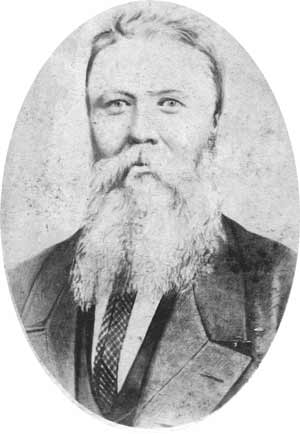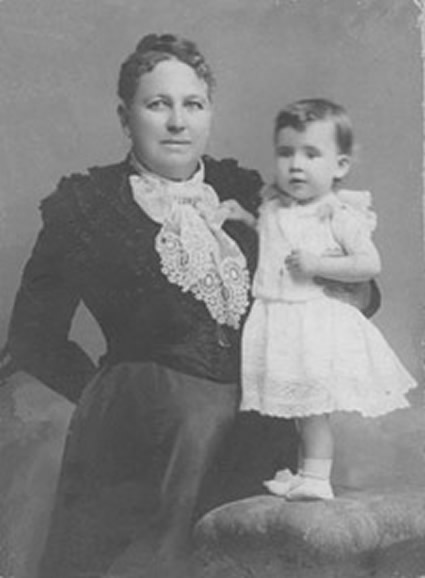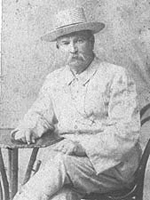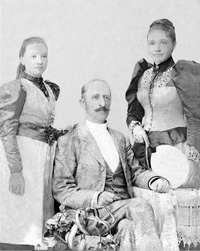Samuel Sneyd
Samuel Sneyd (1811-1885) was a prominent citizen of early Brisbane, its Chief Constable from 1849 and then governor of the Brisbane Gaol. He was born in Hanley, Stoke-on-Trent, Staffordshire, UK, in 1811, to Samuel Sneyd, a grocer of Hanley, and Elizabeth Margaret Oliver. His sister Mary was born 1814 and James in 1818, in Hanley.
Samuel arrived in New South Wales in 1831 as a soldier of the 4th Foot Lancaster Kings Own Regt) and was a mounted trooper in Wollongong when he married Catherine Mulcahy. His marriage notice of 23 Feb 1837 refers to 'Mr Sneyd, Commanding the Mounted Police at Wollongong' and states he had married 'Miss Kitty Mulcahy of Black Rock near Cork, Ireland, emigrant (per ship James Pattison)'. Catherine was one of the 2700 females sponsored for emigration by the London Emigration Society between 1832 and 1837 (see rushen.com.au). She had arrived a year before on 7 February 1836, apparently leaving behind a daughter who later emigrated to the United States (letter from Mrs Carleton of California to Colin McIntyre about 1965). She was to have another nine children before her death in 1858 in Brisbane (see opposite panel). Sneyd gave his first boys second names after his postings—Hartley, Goulburn and Braidwood.
Glimpses of Sneyd's police service are emerging as newspaper records of early colonial life are made digitally accessible. A recent publication (A. Dukova, To Preserve and Protect, Policing Colonial Brisbane, University of Qld Press, 2020) devotes its second chapter to Samuel Sneyd with many details of his service as well as familiar biographical details recorded here. In this history, Sneyd is portrayed as an important transitional figure in establishing the Queensland police force.
His obituary in The Queenslander of 11 July 1885 stated that 'in the early days of New South Wales he was selected as one of the picked men from the regiment to suppress bushranging in that colony'. It appears Sneyd soon came to notice for his efforts in capturing bushrangers. In September 1839 he is with the Bowen Hollow Police, assisting the Mt Victoria Police apprehend 'three notorious bushrangers' near Hartley. Soon after, in November 1839 Sydney papers report his courage in leading the capture and fatal shooting of other bushrangers in a raid near Lithgow. The Sydney Monitor stated 'Great praise is due to Serjeant Sneyd, who showed a great deal of courage in the taking of them'. The trial of the bushtrangers and Sneyd's testimony is recorded in an early court record, as well as newspapers. These mention the role of Aboriginal trackers (in R.v Chubb, 1840, see Macquarie University's project on Decisions of the Superior Courts of New South Wales, 1788-1899).
In May 1841 he is reported in Goulburn pursuing bushrangers who had robbed the Yass Mail (Australasian Chronicle). He was Sgt Major of the Goulburn division in 1849 (aged 38) when he was appointed Chief Constable of the District of Moreton Bay (early Brisbane). He must have spent some years in Goulburn since he seeks leave from the Colonial Secretary to wait for his family to join him from Goulburn before leaving Sydney to take up his appointment. As Chief Constable, he was also appointed to other offices, such as Inspector of Slaughterhouses and Inspector of Distilleries. References to Mr Chief Constable Sneyd appear in newspapers at this time, active in day to day police work and Court appearances. There is evidence he did his work well, commended by the bench in May 1850 case for 'the remarkable vigilance and promptitude displayed by Mr. Chief Constable Sneyd' in tracing stolen property. In 1852, he is dealing with frontier conflict with Aborigines robbing farmers.In September 1852 he leads a party to apprehend one of the 'Pine River Marauders', a group of Aborigines near Breakfast creek. [Research so far to 1855, see further details in Dukova's To Preserve and Protect].
In November 1859 he was appointed governor of the Brisbane Gaol in the first months of the new colony of Queensland. The Moreton Bay Courier noted 'As a public officer, Mr. Sneyd has made himself deservedly respected for the integrity of his character, and the ability with which he has discharged his duties. The injury inflicted on his constitution by hard bush-work both night and day, in former years, has told upon him lately to such a degree that he has not been able satisfactorily to perform his night duties, and he accordingly made up his mind to resign his office'. He was by this time an authority on the criminal justice system and is cited in Persons called before Government Committees Index (1861 on native police and 1867 on prison discipline). After Catherine's death in 1858, he married Margaret Hyland in 1859, former matron of the gaol, with whom he had five children of the second family. He died in 1885 aged 74 after some years on his farm at Enogera. The Queenslander concluded its obituary by saying he 'was a fine specimen of a bluff but kindly-hearted Englishman, and was highly respected by those with whom he came in contact'.
There are hundreds of descendants from his fourteen children, many of whom are still living in Queensland. Descendants are invited to submit further information and images of the Sneyd children of the first and second families for publication on this page (send to to john at artpages.com.au). There is also contact through the Roots Web list, SNEYD-L@rootsweb.com.
See a separate listing of the two Sneyd families and further information about Catherine Sneyd.
Compiled by John McIntyre (descendant of Elizabeth Margaret McIntyre, daughter of Samuel Sneyd). Last revised December 2020 with additions through TROVE research on digitised newspapers at the National Library of Australia.
